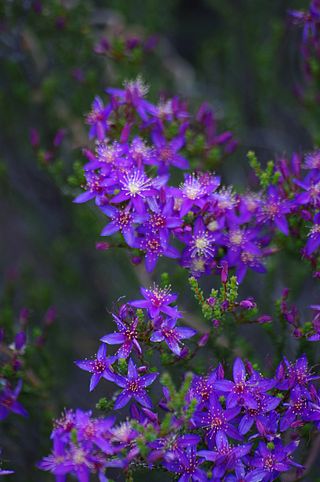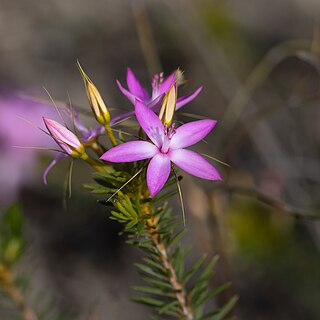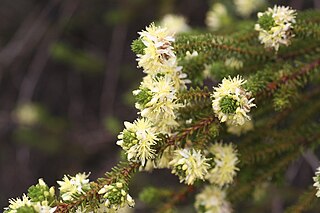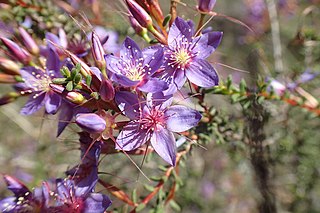
Calytrix aurea is a species of flowering plant in the myrtle family Myrtaceae and is endemic to the south-west of Western Australia. It is a shrub with elliptic, lance-shaped or linear leaves and clusters of yellow flowers with 25 to 55 yellow stamens in several rows.

Calytrix leschenaultii is a species of flowering plant in the myrtle family Myrtaceae and is endemic to the Southwest Australia of Western Australia. It is a mostly glabrous shrub with egg-shaped, elliptic, lance-shaped or linear leaves and purple, mauve, violet or pink flowers with a white or yellow base, and 6 to 40 white or yellowish stamens.

Calytrix acutifolia is a species of flowering plant in the myrtle family Myrtaceae and is endemic to south-west of Western Australia. It is a slender, openly-branched shrub with linear to lance-shaped leaves and clusters of white, cream-coloured or yellow flowers with 40 to 85 white stamens in several rows.

Calytrix brevifolia is a species of flowering plant in the myrtle family Myrtaceae and is endemic to the west of Western Australia. It is a glabrous shrub with egg-shaped, linear, elliptic or more or less round leaves and clusters of pink to magenta flowers with about 40 to 90 yellow stamens in 4 rows.

Calytrix chrysantha is a species of flowering plant in the myrtle family Myrtaceae and is endemic to the south-west of Western Australia. It is a glabrous shrub usually with oblong to linear leaves and clusters of yellow flowers with about 45 to 55 yellow stamens in several rows.

Calytrix decandra, commonly known as pink starflower, is a species of flowering plant in the myrtle family Myrtaceae and is endemic to the south of Western Australia. It is a semi-prostrate, glabrous shrub with linear to narrowly elliptic leaves and pink, mauve or magenta flowers with usually 10 stamens in a single row.

Calytrix drummondii is a species of flowering plant in the myrtle family Myrtaceae and is endemic to the Geraldton Sandplains bioregion of Western Australia. It is a glabrous shrub with linear leaves, and yellow flowers with about 55 to 85 yellow stamens in several rows.
Calytrix ecalycata is a species of flowering plant in the myrtle family Myrtaceae and is endemic to the south-west of Western Australia. It is a slender, erect shrub with linear to narrowly elliptic leaves, and yellow flowers with 35 to 50 stamens in several rows.
Calytrix eneabbensis is a species of flowering plant in the myrtle family Myrtaceae and is endemic to the south-west of Western Australia. It is a glabrous shrub with lance-shaped leaves and purple and yellowish flowers with 40 to 60 stamens in several rows.
Calytrix erosipetala is a species of flowering plant in the myrtle family Myrtaceae and is endemic to inland areas of Western Australia. It is a glabrous shrub with spreading lance-shaped to egg-shaped or linear leaves, and white to pink flowers with about 18 to 24 stamens in a single row.

Calytrix flavescens, commonly known as summer starflower, is a species of flowering plant in the myrtle family Myrtaceae and is endemic to the south-west of Western Australia. It is a shrub with linear to narrowly elliptic leaves, and yellow flowers with about 35 to 60 stamens in several rows.

Calytrix fraseri, commonly known as pink summer calytrix or pink summer starflower, is a species of flowering plant in the myrtle family Myrtaceae and is endemic to the south-west of Western Australia. It is a shrub with oblong, linear or elliptic leaves with the narrower end towards the base, and pink, cerise or pinkish purple flowers with about 35 to 55 stamens in several rows.

Calytrix glutinosa is a species of flowering plant in the myrtle family Myrtaceae and is endemic to the south-west of Western Australia. It is a more or less glabrous shrub with linear leaves and clusters of pink to mauve flowers with about 10 to 20 white stamens in one or two rows, becoming reddish-purple as they age.
Calytrix gypsophila, commonly known as gypsum fringle-myrtle, is a species of flowering plant in the myrtle family Myrtaceae and is endemic to southern continental Australia. It is a glabrous shrub with oblong, linear or lance-shaped leaves with the narrower end towards the base, and white flowers with 25 to 40 stamens in a single row.
Calytrix paucicostata is a species of flowering plant in the myrtle family Myrtaceae and is endemic to a restricted area in the west of Western Australia. It is a shrub with linear leaves and bright to rich pink flowers with about 75 to 88 stamens in several rows.

Calytrix violacea is a species of flowering plant in the myrtle family, Myrtaceae and is endemic to the southwest of Western Australia. It is a shrub with linear to narrowly egg-shaped leaves with the narrower end towards the base, and purple, star-shaped flowers.
Calytrix purpurea is a species of flowering plant in the myrtle family Myrtaceae and is endemic to the south-west of Western Australia. It is a spreading shrub with linear leaves and purple flowers with a yellow base, and about 45 to 55 yellow stamens in four rows.
Calytrix gomphrenoides is a species of flowering plant in the myrtle family Myrtaceae and is endemic to the Kimberley region of Western Australia. It is a glabrous, multi-stemmed shrub with linear leaves and white flowers turning pink as they age, with 16 to 18 stamens in a single row.

Calytrix hirta is a species of flowering plant in the myrtle family Myrtaceae and is endemic to the south-west of Western Australia. It is a spreading shrub with linear to slightly curved leaves and clusters of white flowers with 32 to 46 white stamens in several rows.
Calytrix retrorsifolia is a species of flowering plant in the myrtle family Myrtaceae and is endemic to a restricted part of the south-west of Western Australia. It is a slender, spreading, open shrub with linear leaves and clusters of white flowers with 23 to 40 white stamens in several rows.











